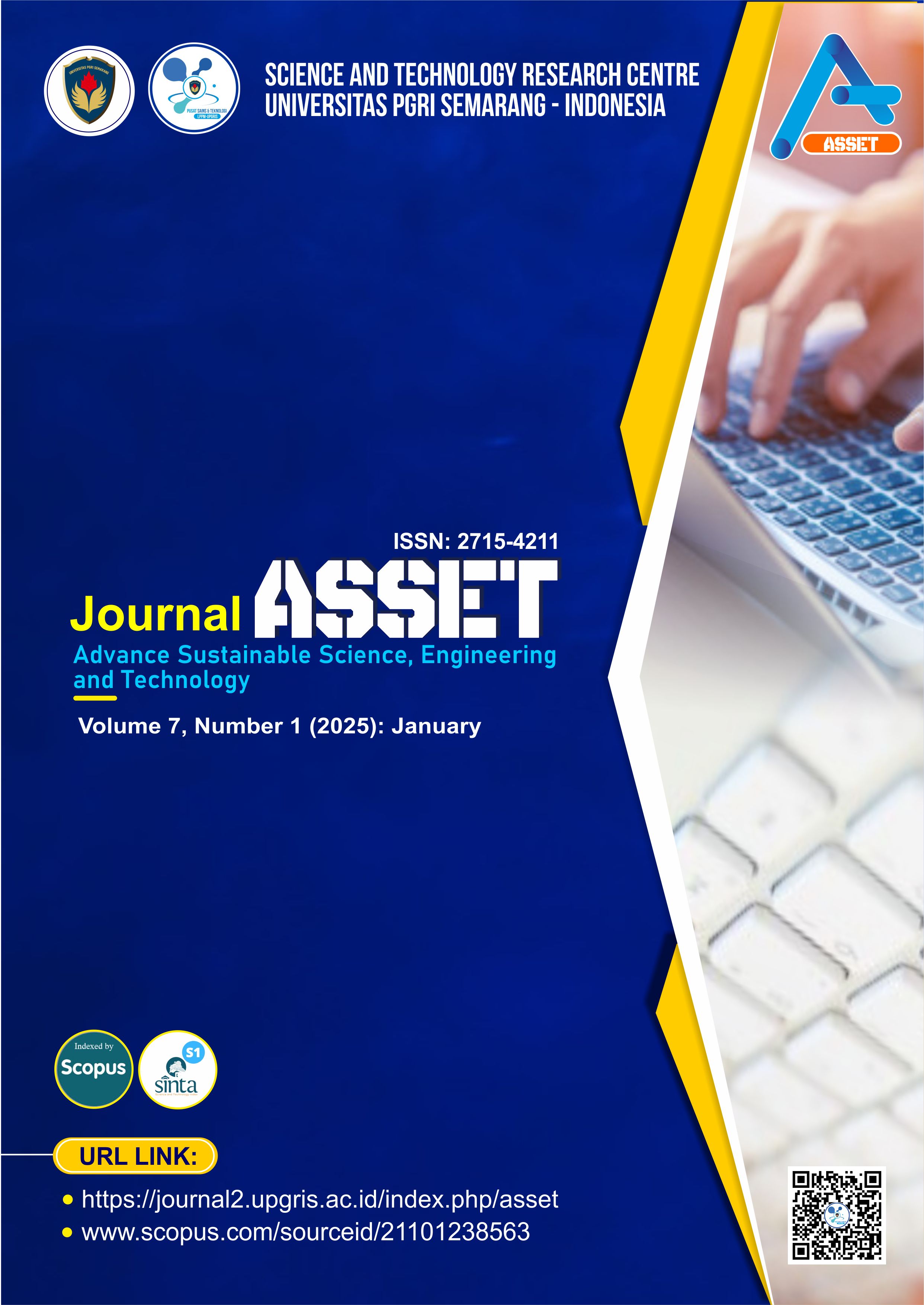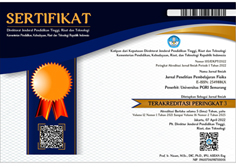Innovation of Artistic Gymnastics Equipment in Limited Space
DOI:
https://doi.org/10.26877/asset.v7i1.1147Keywords:
artistic gymnastics, sports biomechanics, training tool, training equipment for gymnasticsAbstract
This study was motivated by the limited space for men's artistic gymnastics in Central Java, which generally uses a small and unrepresentative school arena, so the arrangement of equipment such as uneven bars, parallel bars, rings and saddle horses is not optimal. The aim of this study is to develop innovative multifunctional artistic gymnastics equipment in a limited space to optimise the gross motor development of junior male artistic gymnasts and to improve the effectiveness and efficiency of training. The research method uses a research and development approach with quantitative data from expert questionnaires, athletes and coaches, as well as analysis of equipment innovation based on Computer Aided Design (CAD) technology. The results of the analysis showed the maximum stress on the developed equipment, namely single bars 45.7 MPa, parallel bars 72.6 MPa, straps 29.48 MPa and saddles 92.9 MPa, which are located at the ends near the pivot point. The results of the analysis showed that the Innovation products are safe to use. The conclusion the conclusion of this research is the creation of artistic gymnastics equipment innovation in a limited space that is feasible to use.
References
[1] S. Tayne, L. Bejarano-Pineda, and M. R. Hutchinson, “Gymnastics (Artistic, Rhythmic, Trampoline),” 2021, Springer International Publishing. doi: 10.1007/978-3-030-66321-6_5.
[2] G. Cervin, “Ringing the Changes: How the Relationship between the International Gymnastics Federation and the International Olympic Committee Has Shaped Gymnastics Policy,” 2020, Human Kinetics. doi: 10.1123/shr.2019-0041.
[3] J. Weber, “DEMANDS PROFILE IN WHEEL GYMNASTICS,” 2022, University of Ljubljana. doi: 10.52165/sgj.14.1.119-130.
[4] E. R. Sukamti and A. Chrisnanda, “Developing Basic Techniques of Artistic Gymnastics Book: Gymnastics on Motion,” 2019, SCITEPRESS - Science and Technology Publications. doi: 10.5220/0009303901760179.
[5] S. Linge, O. Hallingstad, and F. Solberg, “Modelling the parallel bars in Men’s Artistic Gymnastics,” Hum Mov Sci, vol. 25, no. 2, pp. 221–237, 2006, doi: https://doi.org/10.1016/j.humov.2005.11.008.
[6] H. Zhang, J. Chai, and C. Li, “On innovative strategies of youth sports teaching and training based on the internet of things and artificial intelligence technology from the perspective of humanism,” Learn Motiv, vol. 86, p. 101969, 2024, doi: https://doi.org/10.1016/j.lmot.2024.101969.
[7] Z. Chen and X. Dai, “Utilizing AI and IoT technologies for identifying risk factors in sports,” Heliyon, vol. 10, no. 11, p. e32477, 2024, doi: https://doi.org/10.1016/j.heliyon.2024.e32477.
[8] Y. Qi, S. M. Sajadi, S. Baghaei, R. Rezaei, and W. Li, “Digital technologies in sports: Opportunities, challenges, and strategies for safeguarding athlete wellbeing and competitive integrity in the digital era,” Technol Soc, vol. 77, p. 102496, 2024, doi: https://doi.org/10.1016/j.techsoc.2024.102496.
[9] F. Wang, T. Zhang, Q. Zhou, and Y. Lu, “Comparison of the morphological accuracy of automatic crowns designed by multiple computer-aided design software programs with different levels of dentition information acquisition,” J Prosthet Dent, vol. 132, no. 2, pp. 441–452, 2024, doi: https://doi.org/10.1016/j.prosdent.2023.01.024.
[10] L. Pelliccia, M. Bojko, R. Prielipp, and R. Riedel, “Applicability of 3D-factory simulation software for computer-aided participatory design for industrial workplaces and processes,” Procedia CIRP, vol. 99, pp. 122–126, 2021, doi: https://doi.org/10.1016/j.procir.2021.03.019.
[11] C. Yuza, M. Asmawi, and W. widiastuti, “Model Latihan Gerak Dasar Senam Lantai B-Gym Untuk Pemula (Usia 9-12 Tahun),” Jurnal Segar, vol. 7, no. 2, pp. 1–11, Sep. 2019, doi: 10.21009/segar/0702.01.
[12] B. Mkaouer, S. Amara, R. Bouguezzi, A. Ben Abderrahmen, and H. Chaabene, “Validity of a new sport-specific endurance test in artistic gymnastics,” Front Sports Act Living, vol. 5, p. 1159807, Sep. 2023, doi: 10.3389/fspor.2023.1159807.
[13] R. B. Aji-Putra, T. Rahayu, W. Kasmini, and Sulaiman, “The software instrument for gymnast posture analysis,” Journal of Human Sport and Exercise, vol. 17, no. 2, Sep. 2020, doi: 10.14198/jhse.2022.172.20.
[14] H. Aliriad, S. Soegiyanto, H. Setijono, and S. Sulaiman, “Effect of the Project-based Learning Model, Age, and Motor Educability on Fundamental Motor Skills in Early Children,” Health Education and Health Promotion, vol. 11, no. 1, pp. 125–131, 2023, doi: http://dx.doi.org/10.58209/hehp.11.1.125.
[15] H. Aliriad, S. Adi, J. G. Manullang, I. B. Endrawan, and M. H. Satria, “Improvement of Motor Skills and Motivation to Learn Physical Education Through the Use of Traditional Games,” Physical Education Theory and Methodology, vol. 24, no. 1, pp. 32–40, 2024, doi: https://doi.org/10.17309/tmfv.2024.1.04.
[16] C. Schärer, L. Reinhart, and K. Hübner, “Age-Related Differences between Maximum Flight Height of Basic Skills on Floor, Beam and Vault and Physical Condition of Youth Female Artistic Gymnasts,” Sports, vol. 11, no. 5, p. 100, Sep. 2023, doi: 10.3390/sports11050100.
[17] S. Kaufmann et al., “Energetics of Floor Gymnastics: Aerobic and Anaerobic Share in Male and Female Sub-elite Gymnasts,” Sports Med Open, vol. 8, no. 1, p. 3, Sep. 2022, doi: 10.1186/s40798-021-00396-6.
[18] N. Barker-Ruchti, R. Kerr, A. Schubring, G. Cervin, and M. Nunomura, “‘Gymnasts Are Like Wine, They Get Better With Age’: Becoming and Developing Adult Women’s Artistic Gymnasts,” 2016, Informa UK Limited. doi: 10.1080/00336297.2016.1230504.
[19] Chandra and Y. Jutalo, “Pengembangan Prototipe Alat Tumble Track Trampoline Pada Cabang Olahraga Senam Trampoline Dki Jakarta,” Jurnal Segar, vol. 10, no. 2, pp. 95–97, Sep. 2022, doi: 10.21009/segar/1002.06.
[20] chandra and H. J. Yansen, “Pengembangan Prototipe Alat Double Mini Trampoline (DMT) Pada Cabang Olahraga Senam Trampoline DKI Jakarta,” Jurnal Segar, vol. 11, no. 2, pp. 47–54, Sep. 2023, doi: 10.21009/segar/1102.01.
[21] T. M. Barbosa et al., “The role of the biomechanics analyst in swimming training and competition analysis,” Sports Biomech, vol. 22, no. 12, pp. 1734–1751, Apr. 2021, doi: 10.1080/14763141.2021.1960417.
[22] M. Kamal, “RESEARCH AND DEVELOPMENT (R&D),” Al-Afkar: Manajemen pendidikan Islam, vol. 7, no. 2, pp. 1–22, 2019.
[23] G. P. Ahmadan, Nasuka, and H. Pramono, “Development of Target Basket Tools for Set-Up and Receive Serve Precise Practice in Volleyball Games,” Journal of Physical Education and Sports, vol. 7, no. 2, pp. 185–192, 2018.
[24] M. Mulyadi, “Buku Ajar CAD/CAM (Computer Aided Design / Computer Aided Manufacturing),” 2018, Umsida Press. doi: 10.21070/2018/978-602-5914-10-2.
[25] C. Pinheiro and N. Pimenta, “A figurational approach to women’s artistic gymnastics,” 2020, Routledge. doi: 10.4324/9781003007005-13.
[26] M. Kalichkova, “INNOVATION OF THE SUBJECT OF ARTISTIC GYMNASTICS AT UNIVERSITIES WITH A SPORTS FOCUS - SAFE GYMNASTICS 4ALL (Erasmus+ project),” 2024, University of Ljubljana. doi: 10.52165/sgj.16.1.160-162.
[27] I. V. Ivanova, “SPORTS PROFILE OF ELITE ATHLETES IN RHYTHMIC GYMNASTICS,” 2022, University of Ljubljana. doi: 10.52165/sgj.14.1.73-88.
[28] Suharti, Nurhasan, and O. Wiriawan, “The Influence of Physical Fitness Gymnastics 2017 and Indonesian Jaya Gymnastics toward Flexibility and Endurance,” 2019, Africa Health Research Organization. doi: 10.36295/asro.2019.221119.
[29] F. J. Cleophas and U. T. Visser, “ROOTS, ORIGINS AND DEVELOPMENT OF RHYTHMIC GYMNASTICS: A HISTORICAL INSIGHT,” 2024, University of Ljubljana. doi: 10.52165/sgj.16.1.67-76.
[30] M. Benzie, “ACHILLES RUPTURES AND RETURN TO SPORT IN GYMNASTICS: AN OVERVIEW,” 2024, University of Ljubljana. doi: 10.52165/sgj.16.1.29-41.
[31] E. Nyman, “Biomechanics of Gymnastics,” 2019, Springer International Publishing. doi: 10.1007/978-3-030-26288-4_3.
[32] B. Risby and A. Palouda, “Fantastic Gymnastics,” 2021, Routledge. doi: 10.4324/9781003236290-1.
[33] J. L. Shapiro, M. L. Bartlett, and L. E. Lomonte, “Psychological Aspects of Injury in Gymnastics,” 2019, Springer International Publishing. doi: 10.1007/978-3-030-26288-4_5.
[34] W. A. Sands, G. C. Bogdanis, G. Penitente, and O. Donti, “ASSESSING INTEREST IN ARTISTIC GYMNASTICS,” 2021, University of Ljubljana. doi: 10.52165/sgj.13.1.5-18.
[35] D. Bento-Soares and L. M. Schiavon, “GYMNASTICS FOR ALL: DIFFERENT CULTURES, DIFFERENT PERSPECTIVES,” 2020, University of Ljubljana. doi: 10.52165/sgj.12.1.5-18.
[36] D. R. Hidayanto, A. Kristiyanto, and S. K. Purnama, “Development Model of Basic Skills Training Shot Put O’Brien Style Techniques Based on Biomechanical Studies,” in International Seminar on Public Health and Education 2018 (ISPHE 2018), Atlantis Press, 2018, pp. 72–76.
[37] V. Panoutsakopoulos and I. A. Kollias, “Reliability of a Pendulum Apparatus for the Execution of Plyometric Rebound Exercises and the Comparison of Their Biomechanical Parameters with Load-Matching Vertical Drop Jumps,” 2023, MDPI AG. doi: 10.3390/biomechanics3020018.
[38] A. Lamošová, O. Kyselovičová, and P. Tomková, “ANTHROPOMETRIC AND MOTOR CHANGES AFTER ONE-YEAR AEROBIC GYMNASTICS TRAINING IN YOUNG GYMNASTS,” 2021, University of Ljubljana. doi: 10.52165/sgj.13.2.243-251.
[39] M. Rico-González, L. P. Ardigò, A. P. Ramírez-Arroyo, and C. D. Gómez-Carmona, “Anthropometric Influence on Preschool Children’s Physical Fitness and Motor Skills: A Systematic Review,” 2024. doi: 10.3390/jfmk9020095.
[40] M. R. Islam et al., “Accelerometer-Measured Physical Activity, Fitness and Indicators of Cardiometabolic Risk among Rural Adolescents: A Cross-Sectional Study at 15-Year Follow-up of the MINIMat Cohort,” 2024. doi: 10.1007/s44197-024-00245-1.
[41] L. K. Ritchie, N. Ronshaugen, and J. Sygo, “Growth and Development in Gymnastics,” 2019, Springer International Publishing. doi: 10.1007/978-3-030-26288-4_4.
[42] A. Batista, R. Garganta, and L. Ávila-Carvalho, “BODY DIFFICULTIES IN RHYTHMIC GYMNASTICS ROUTINES,” 2023, University of Ljubljana. doi: 10.52165/sgj.11.1.37-55.
[43] T. Haigis and K. Schlegel, “THE REGULATORY INFLUENCE OF THE VISUAL SYSTEM: AN EXPLORATORY STUDY IN GYMNASTICS VAULTING,” 2020, University of Ljubljana. doi: 10.52165/sgj.12.1.61-73.
[44] M. Azaza, A. Eskilsson, and F. Wallin, “Energy flow mapping and key performance indicators for energy efficiency support: a case study a sports facility,” Energy Procedia, vol. 158, pp. 4350–4356, 2019, doi: https://doi.org/10.1016/j.egypro.2019.01.785.
[45] O. Kyselovičová, E. Zemková, K. Péliová, and L. Matejová, “Isokinetic leg muscle strength relationship to dynamic balance reflects gymnast-specific differences in adolescent females,” Front Physiol, vol. 13, p. 1084019, Sep. 2023, doi: 10.3389/fphys.2022.1084019.
[46] P. Peláez-Gorrea et al., “Biomechanical evaluation of chondral lesions in sheep model treated with hyaline cartilage suspended in plasma rich in growth factors and prgf intraarticular injection (CN-Biomatrix) by force platform. preliminary results,” Osteoarthritis Cartilage, vol. 29, pp. S69–S70, 2021, doi: https://doi.org/10.1016/j.joca.2021.02.099.
[47] L. Huang, Z. Yang, R. Wang, and L. Xie, “Physiological and biomechanical effects on the human musculoskeletal system while carrying a suspended-load backpack,” J Biomech, vol. 108, p. 109894, 2020, doi: https://doi.org/10.1016/j.jbiomech.2020.109894.











